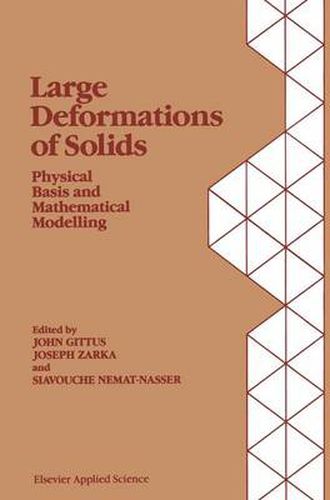Readings Newsletter
Become a Readings Member to make your shopping experience even easier.
Sign in or sign up for free!
You’re not far away from qualifying for FREE standard shipping within Australia
You’ve qualified for FREE standard shipping within Australia
The cart is loading…






A central problem in engineering is the deformation of structures. These may be structures made of metal, from concrete or other buildingmaterials,orfrom soilforexample. Generallyspeaking, the engineerrequiresthedeformationofastructuretoberelativelysmall, predictable, tolerable and non-damaging. Professor Jean Mandel devotedalargepartofhisprofessionalcareertostudiesofdeforma- tionandhewassuccessfulinidentifyingprinciplesandproceduresof wideapplicability.Accordingly,itisveryappropriatetobringtogether as we dointhis volume papers by world authorities concerned with deformationinmemoryofProfessorMandel. The papers in this volume were all invited contributions to an international CNRS colloquium which was held at the Ecole Poly- techniqueinParis, 30September-2October1985. Thevolumeconsidersthedeformationofmetals,rocks,composites, soils, sand and wood. The microscopic processes and theory of deformationaretreated, asarethegenerallawsrelatingdeformation with parameters such as stress system and temperature. A central problemwhichhasbeensystematicallyattackedinthecaseofmetalsis the relationship between the behaviour of crystal defects such as dislocations and the deformationofa large specimenorengineering component.Itshould be possible to produce accurate predictionsof macroscopic deformation from a microscopic model and substantial progresstowardsthisendhasbeenmadeinrecentyears.Thefirsttwo sectionsofthe bookare largelyconcerned with progress in this very importantarea. A parallel theme which was established in earlier days is the developmentofcontinuummodelsfordeformation.Suchmodelswere proposedatatimewhenmicroscopyhadnotdevelopedtoitspresent levelofsophisticationsothat,forexample,itwasnotestablishedthat v VI PREFACE crystalsactuallycontaineddislocations.Thecontinuumtheorieswhich datebackmorethanacenturysoughttoexplainmicroscopicdeforma- tion in terms of abstract models involving mechanical elements of whichthespringand the dashpot wereprominentexamples. Froma strictly practical standpoint these continuum models still have great utilitytoday, particularlyinareaswhere the materialsaresocompli- cated that the preferred route, linking microscopic behaviour with macroscopicbehaviour, is notyet available. Section3ofthe book is concernedthereforewiththecontinuumpointofviewformetals.
$9.00 standard shipping within Australia
FREE standard shipping within Australia for orders over $100.00
Express & International shipping calculated at checkout
A central problem in engineering is the deformation of structures. These may be structures made of metal, from concrete or other buildingmaterials,orfrom soilforexample. Generallyspeaking, the engineerrequiresthedeformationofastructuretoberelativelysmall, predictable, tolerable and non-damaging. Professor Jean Mandel devotedalargepartofhisprofessionalcareertostudiesofdeforma- tionandhewassuccessfulinidentifyingprinciplesandproceduresof wideapplicability.Accordingly,itisveryappropriatetobringtogether as we dointhis volume papers by world authorities concerned with deformationinmemoryofProfessorMandel. The papers in this volume were all invited contributions to an international CNRS colloquium which was held at the Ecole Poly- techniqueinParis, 30September-2October1985. Thevolumeconsidersthedeformationofmetals,rocks,composites, soils, sand and wood. The microscopic processes and theory of deformationaretreated, asarethegenerallawsrelatingdeformation with parameters such as stress system and temperature. A central problemwhichhasbeensystematicallyattackedinthecaseofmetalsis the relationship between the behaviour of crystal defects such as dislocations and the deformationofa large specimenorengineering component.Itshould be possible to produce accurate predictionsof macroscopic deformation from a microscopic model and substantial progresstowardsthisendhasbeenmadeinrecentyears.Thefirsttwo sectionsofthe bookare largelyconcerned with progress in this very importantarea. A parallel theme which was established in earlier days is the developmentofcontinuummodelsfordeformation.Suchmodelswere proposedatatimewhenmicroscopyhadnotdevelopedtoitspresent levelofsophisticationsothat,forexample,itwasnotestablishedthat v VI PREFACE crystalsactuallycontaineddislocations.Thecontinuumtheorieswhich datebackmorethanacenturysoughttoexplainmicroscopicdeforma- tion in terms of abstract models involving mechanical elements of whichthespringand the dashpot wereprominentexamples. Froma strictly practical standpoint these continuum models still have great utilitytoday, particularlyinareaswhere the materialsaresocompli- cated that the preferred route, linking microscopic behaviour with macroscopicbehaviour, is notyet available. Section3ofthe book is concernedthereforewiththecontinuumpointofviewformetals.